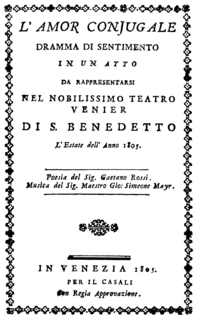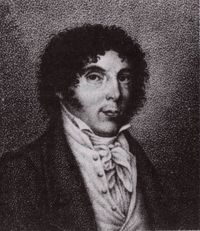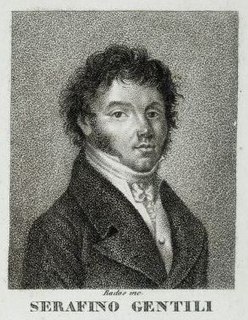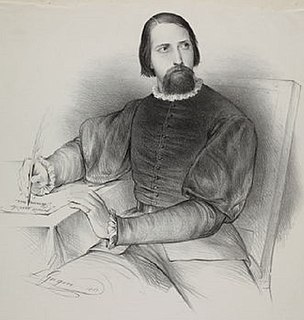La Lodoiska is an opera in three acts by Simon Mayr to an Italian libretto by Francesco Gonella De Ferrari. It was Mayr's second opera and premiered at La Fenice in Venice on 26 January 1796.
The libretto for La Lodoiska was based on an episode from Jean-Baptiste Louvet de Couvrai's novel, Les Amours du chevalier de Faublas , which had also formed the basis for Cherubini's 1791 opera Lodoïska . The opera had a very successful premiere at La Fenice on 26 January 1796 and had 13 more performances that season. Its music and story were also used for a ballet of the same name choreographed by Lorenzo Panzieri, which premiered at La Fenice in January 1797, and the opera itself was revived at La Fenice in November of that year. On 4 November 1798 it had its first performance at the Teatro Real de São Carlos in Lisbon in celebration of the name day of Carlota Joaquina of Spain.
Mayr then revised the opera to a two-act version which nevertheless had more musical numbers than the original three-act version. The new version premiered at La Scala on 26 December 1799. It was Mayr's first opera to be performed there and its success led to more commissions from La Scala and other Milanese theatres. La Lodoiska in its revised version was then performed in Turin at the Teatro Regio in 1804 and in Naples at the Teatro San Carlo in 1818 when the title role was sung by Isabella Colbran. The opera was very popular in its day but then fell into obscurity.
| Role | Voice type | Premiere cast [1] 26 January 1796 |
|---|---|---|
| Lodoiska, a Polish princess in love with Lovinski | soprano | Teresa Maciorletti Blasi |
| Lovinski, a Polish lord using the name "Siveno" | soprano castrato | Luigi Marchesi |
| Boleslao, lord of the Castle of Ostropoll | tenor | Giuseppe Carri |
| Resiska, confidante of Lodoiska | soprano | Teodosia Ferraglia |
| Narseno, Lovinski's companion | mezzo-soprano castrato (1st version) bass (2nd version) | Pietro Bonini |
| Radoski, confidante of Boleslao | tenor | Filippo Martinelli |
| Giskano, a Tartar warrior-prince | bass | Antonio Ricci |
| Sigeski, Lodoiska's father | bass | Giacomo Zamboni |
Princess Lodoiska has been entrusted by her father to the care of Boleslao, lord of the Castle of Ostropoll. Boleslao wants to marry Lodoïska, but she is in love with Lovinski and rejects his advances. Lovinski arrives (under the name "Siveno") to ask for Princess Lodoïska on behalf of her father, but Boleslao refuses to let her go. When Lodoïska's father, Sigeski, arrives and confronts him, the tyrannical Boleslao imprisons both Sigeski and Lovinski and plans the death of the young lovers. All are saved at the end when they are rescued by Giskano, a Tartar warrior-prince, whose life Lovinski had once saved. [2]

Torvaldo e Dorliska is an operatic dramma semiserio in two acts by Gioachino Rossini to an Italian libretto by Cesare Sterbini, based on the novel/memoir Les Amours du chevalier de Faublas (1787–1790) by the revolutionary Jean-Baptiste Louvet de Couvrai, whose work was the source of the Lodoïska libretto set by Luigi Cherubini (1791), and Lodoiska set by Stephen Storace (1794), and Simon Mayr (1796).
Giulietta e Romeo is a dramma per musica by composer Niccolò Antonio Zingarelli with an Italian libretto by Giuseppe Maria Foppa after the 1530 novella of the same name by Luigi da Porto. The opera premiered at the Teatro alla Scala in Milan on 30 January 1796.

Medea is an opera in three acts composed by Giovanni Pacini to a libretto by Benedetto Castiglia. It premiered on 28 November 1843 at the Teatro Carolino in Palermo, conducted by the composer with Geltrude Bortolotti in the title role. The libretto is based on the plays Medea by Euripides and Médée by Pierre Corneille.

L'amor coniugale is an opera in one act by Simon Mayr set to an Italian libretto by Gaetano Rossi. It premiered at Padua's Teatro Nuovo on 26 July 1805.

Didone abbandonata is an opera in three acts composed by Domenico Sarro to a libretto by Pietro Metastasio of the same name which was based on the story of Dido and Aeneas from the fourth book of Virgil's Aeneid. The opera premiered on 1 February 1724 at the Teatro San Bartolomeo in Naples.
Marietta Sacchi was an Italian operatic soprano who had an active career during the 1820s and 1830s.

Stefano Pavesi was an Italian composer. Born in Casaletto Vaprio, he is primarily known as a prolific opera composer, but he also served as the maestro di cappella of Crema Cathedral from 1818 until his death in Crema at the age of 71.

Elisabetta Manfredini-Guarmani was an Italian opera singer best known for having created the leading soprano roles in four of Rossini's operas, roles which he wrote specifically for her voice. She was born Antonia Elisabetta Manfredini in Bologna and was the daughter of the composer and music theorist Vincenzo Manfredini. After her stage debut in 1810 when she sang in the premiere of Stefano Pavesi's Il trionfo di Gedeone at Bologna's Teatro del Corso, she went on to perform at La Fenice, La Scala, Teatro Regio di Torino, Rome's Teatro Argentina and several other opera houses, primarily in Northern Italy. In addition to the roles she created in Rossini's operas, she also sang in the world premieres of operas by several composers who are lesser known today, including Pietro Raimondi, Simon Mayr, and Ferdinando Paër. Her last known appearance was in 1828 after which there is no further trace of her. The date and place of her death are unknown.
Adelaide di Guesclino is an opera in two acts composed by Simon Mayr. The Italian libretto by Gaetano Rossi is based on Voltaire's 1734 play Adélaïde du Guesclin. The opera premiered at La Fenice in Venice on 1 May 1799 with Caterina Angiolini in the title role.
La rosa bianca e la rosa rossa is an opera in two acts composed by Simon Mayr to an Italian libretto by Felice Romani. It premiered at the Teatro Sant'Agostino, Genoa, on 21 February 1813. Set in England against the backdrop of the Wars of the Roses, Romani's libretto is based on René-Charles Guilbert de Pixérécourt's La rose blanche et la rose rouge. Mayr's opera has also been performed under the title Il trionfo dell'amicizia.

Giovanni Guicciardi was an Italian opera singer who sang leading baritone roles in the opera houses of Italy and Portugal. He is most remembered today for having created the role of Count di Luna in Verdi's Il trovatore. He created also several other leading roles in operas by lesser known Italian composers. Guicciardi accumulated a considerable fortune during the course of his career. After his retirement from the stage, he taught without payment in music schools in his native city, Reggio Emilia, and presided over a charity for orphaned musicians. He died in San Polo d'Enza at the age of 64.
Luigi Maria Viviani was an Italian composer, conductor and violinist of Florentine origin. He was primarily noted for his ballet scores, most of them composed for the choreographers Giovanni Galzerani and Antonio Cortesi. His 1851 score for Fausto was particularly praised for its obbligato written for the bimbonclaro.

Antonio Cortesi was an Italian ballet dancer, choreographer, and composer. He was particularly known for the numerous ballets which he created and choreographed in the first half of the 19th Century for major Italian theatres, including La Scala, La Fenice, and the Teatro Regio in Turin.

Serafino Gentili was an Italian opera singer particularly known for his performances in tenore di grazia roles. He sang in opera houses throughout Italy as well as in Paris and Dresden. During the course of his career, he created the role of Lindoro in Rossini's L'italiana in Algeri as well as leading roles in several other operas by less well-known composers. In his later years, he went by the surname Gentili-Donati to distinguish himself from the tenor Pietro Gentili.

Zenobia e Radamisto is an opera in 3 acts and nine scenes by composer Giovanni Legrenzi. The opera uses an Italian language libretto by Ippolito Bentivoglio (1611–1685). The third opera written by Legrenzi, the work premiered on 1 June 1665 at the Teatro Bonacossi in Ferrara in celebration of the marriage of Nicolò Santini and Maria Luisa Bonvisi. The opera was subsequently mounted in Brescia (1666), Verona (1667), and Macerata (1669).

Maria Ester Mombelli was an Italian opera singer particularly known for her performances in operas by Rossini and Donizetti. She sang both soprano and mezzo-soprano roles, and often sang with her younger sister Anna.

Eliodoro Bianchi was an Italian operatic tenor and later a prominent singing teacher. Born in Cividate al Piano and trained in Naples under Giacomo Tritto, he made his stage debut in 1793. Amongst the many roles he created during the course of his 40-year career were Baldassare in Ciro in Babilonia and the King of Sweden in Eduardo e Cristina, both of which were composed by Rossini expressly for Bianchi's voice. He retired from the stage in 1835 and spent his later years in Palazzolo sull'Oglio, where he died at the age of 75.

Enrico Crivelli was an Italian opera singer who sang leading baritone and bass-baritone roles in the major opera houses of Italy as well as in Spain, Russia, Germany, France, and England. He also composed collections of art songs and published two books on the art of singing. He was born in Brescia, the youngest son of the celebrated tenor Gaetano Crivelli and died in Milan after a career spanning almost 30 years.
Pio Botticelli was an Italian bass-baritone active in the opera houses of Italy from 1810 until the mid-1840s. Amongst the numerous roles he created in world premieres were Pietro il Grande in Donizetti's Il falegname di Livonia and The Caliph in Pacini's La schiava in Bagdad. He also sang the role of Leucippo in the Austrian premiere of Rossini's Zelmira.
Savino Monelli was an Italian tenor prominent in the opera houses of Italy from 1806 until 1830. Amongst the numerous roles he created in world premieres were Giannetto in Rossini's La gazza ladra, Enrico in Donizetti's L'ajo nell'imbarazzo and Nadir in Pacini's La schiava in Bagdad. He was born in Fermo where he initially studied music. After leaving the stage, he retired to Fermo and died there five years later at the age of 52.